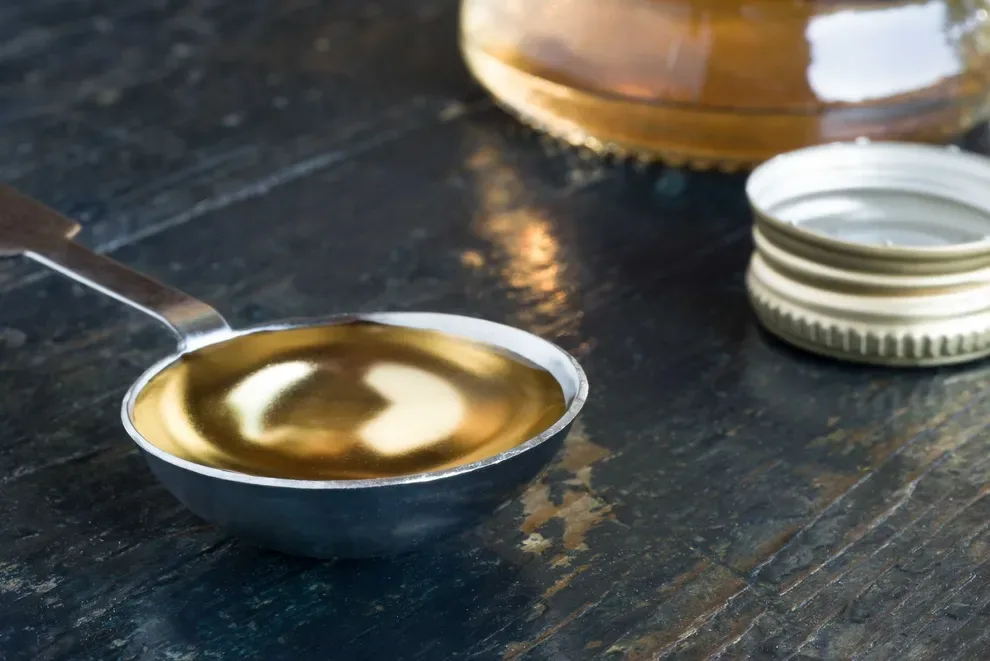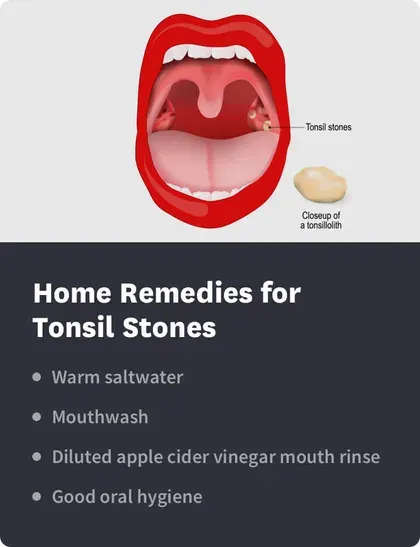Tonsil Stone Removal: What Actually Works?

Table of Contents
- Tonsil Stones Self-Removal
- Symptoms of Tonsil Stones
- Home Remedies
- Tonsillectomy
- Alternatives to Tonsillectomy
- How to Prevent Tonsil Stones
- Chronic Halitosis or Other Symtpoms
- References
The best way to remove tonsil stones is with a solid oral hygiene routine. Rinse with mouthwash or warm salt water a few times daily, and this will typically remove the tonsil stones over time.
If this isn’t effective, you may need to have very large or bothersome tonsil stones surgically removed. But surgical removal is very rare.
Can I Remove Tonsil Stones?
Tonsil stones, or tonsilloliths, are common, and they typically have no disruptive symptoms. About 8 percent of people develop tonsil stones. When you look in a mirror and open your mouth, you can look toward the back of your throat and perhaps see a few whitish specks. These may be tonsil stones.
Many people never even know they have tonsil stones. They could have instances of bad breath, or they may even experience a temporary sore throat, but they don’t know the cause. Tonsil stones usually dislodge on their own and require no treatment. In rare cases, you need to manage them, especially if your dentist has determined that tonsil stones are the cause of your halitosis. It is unlikely that you will need any invasive procedures since home remedies are often effective at dislodging the stones, but sometimes, surgical procedures are needed to remove chronic or large tonsil stones.
Symptoms of Tonsil Stones
While many people can experience tonsil stones without knowing it, some may experience symptoms like these:
Foul-smelling breath (halitosis)
Repeated and unexplained coughing
Aching in ear
Problems swallowing, and/or a feeling of something lodged in throat
Tonsils that appear to have light patches
Unpleasant and unfamiliar taste in mouth
Coughing up small stones (white or yellowish in color)
Painful sore throat and/or unexplained throat infections
Home Remedies for the Removal of Tonsil Stones
You are not likely to even need home remedies to manage tonsil stones. If you do find you frequently develop them, and they affect the smell of your breath or cause an uncomfortable sore throat or earache, you can typically manage tonsil stones on your own at home.
Here are some options for treating tonsil stones at home:

Warm Water
Gargling with warm salt water can help to alleviate pain from a sore throat, earache, sinuses draining from allergies, a cold, or tonsil stones. Water should be warmer than room temperature, but not hot. Adding salt provides some antimicrobial properties, which can remove bacteria that may cause tonsil stones.
Vigorous gargling once or twice per day can dislodge tonsil stones and alleviate other underlying causes of bad breath.
Mouthwash
Using an over-the-counter mouthwash, particularly one that is alcohol-free, can help to lessen bad breath immediately, and it can also potentially dislodge tonsil stones. You can add some water to a little mouthwash to reduce the sting of alcohol or menthol in the product if you are concerned about the sensation in your mouth. Do not swallow the mouthwash, but spit it out after vigorously gargling.
Apple Cider Vinegar
Diluting some apple cider vinegar with warm or room temperature water can create a good mouth rinse that may help to dislodge tonsil stones. The acidity of the vinegar may also help to break down tonsil stones.
However, do not consistently use apple cider vinegar as a tonsil stone removal treatment. Vinegar can be corrosive and may cause tooth decay or digestive problems.
Good Oral Hygiene
Tonsil stones can form because of food particles and bacteria in your mouth. While you do not need to use any special tools to reach your tonsils, brushing your teeth twice per day and flossing between your teeth will help to keep bacteria at bay and remove stubborn food particles that you cannot rinse out.
Consult with your dental provider when tonsil stones are large, causing you excessive pain, or blocking your throat or airway. If you are prone to tonsil stones, regular gargling with a mouthwash or warm saltwater can keep them from causing halitosis or other symptoms. If you experience ongoing or worsening symptoms, get in touch with your doctor. Potential issues may include the following:
You have symptoms of tonsil stones but do not see any.
Only a portion of the tonsil stone is removed with home treatment.
Your tonsils become red, swollen, and painful.
You feel pain after removing the tonsil stone at home.
Water Flosser or Waterpik
A water flosser or Waterpik (also called an oral irrigator) uses a stream of water to remove plaque, bacteria, and food particles from the teeth and gums. These devices can reach hard-to-clean areas in between teeth where plaque can accumulate and result in oral problems, including tonsil stones. They’re especially useful for those who have difficulty flossing by hand and those who have dental appliances (such as braces) that can make oral hygiene more difficult.
The stream of water can also be shot on the tonsils to remove bacteria and buildup. Talk to your dentist to see if this treatment is appropriate for your situation.
Consult with your dental provider when tonsil stones are large, causing you excessive pain, or are blocking your throat or airway.
Tonsillectomy to Remove Tonsil Stones
Sometimes, people who develop a large, irritating tonsil stone or consistent and painful tonsil stones consult their doctor for other options. When home remedies are not enough, your doctor or dentist may recommend surgically removing your tonsils, known as a tonsillectomy. Tonsillectomies are most common in children who develop tonsillitis, an infection of the tonsils. However, adults sometimes have their tonsils removed too. One medical theory suggests that chronic, bothersome tonsil stones are an effect of having several bouts of tonsillitis. The presence of tonsillitis or similar symptoms could be caused by tonsil stones as well.A tonsillectomy is a surgical procedure that requires general anesthesia. You will be monitored in the hospital or surgery center as the anesthesia wears off, but you can typically go home the same day. Recovery takes between one and two weeks. During the first week, try to avoid activities involving too many people, as your risk of infection is higher than normal. You should be able to return to normal activities like work or school quickly after the procedure. If you have any ongoing issues once you return home, like a continuing sore throat, swallowing frequently, or bleeding, call your doctor as soon as possible. These complications are very rare. With some relaxation and soft foods, you are well on your way to recovery. Be sure to go to any follow-up appointments your doctor sets for you after the procedure.
Alternatives to Tonsillectomy
With today’s dental advances, there are other in-office options to treat tonsil stones. These include the following:
Laser tonsil cryptolysis: Tonsil stones are often created in the “crypts” of the tonsils, where food particles and bacteria can accumulate to form the stones. With laser tonsil cryptolysis, parts of the tonsils (including the problematic crypts) are removed through vaporization, using a carbon dioxide laser. General anesthesia is used and the procedure is not painful.
Coblation tonsil cryptolysis: This technique uses natural saline and radioactive frequencies to remove parts of the tonsils. Considered to be a more gentle alternative to tonsillectomy, recovery after coblation therapy may take only a few days.
How to Prevent Tonsil Stones
The best way to prevent tonsil stones is to maintain an effective oral hygiene routine. This should include brushing twice a day, flossing daily, and using an antimicrobial mouthwash.
If you are still experiencing tonsil stones or excessive plaque buildup, even with a diligent dental care routine, there may be an underlying issue that needs to be addressed in order to improve your oral health. This could include any of these:
A chronic health condition: Some health problems, including diabetes and certain autoimmune disorders, are linked to tooth decay and gum disease.
Dry mouth: Some medications, lifestyle choices (such as smoking), and health issues can cause dry mouth, which can increase the risk of plaque buildup and decay in the mouth.
Teeth misalignment: An untreated teeth misalignment (malocclusion) can cause tooth decay, problems cleaning the teeth, and friction between teeth and gums that could result in inflammation and bacteria buildup.
Missing teeth: Not replacing a lost tooth can allow for plaque buildup in the area where the tooth is missing.
Contact Your Doctor About Chronic Halitosis or Other Symptoms
Struggling with tonsil stones can be frustrating, but it is important to avoid using tonsil stone removal kits with devices that reach into the back of your throat. Do not use a toothbrush or cotton swab to reach the back of your throat to dislodge the stones, as you could injure yourself.
If you cannot remove tonsil stones by gargling with a mouth rinse, either homemade or store bought, visit your doctor to get appropriate treatment.
Your dentist may notice the formation of tonsil stones. In some instances, this can indicate higher levels of bacteria in your mouth. This could suggest to your dentist that you need more dental cleanings, may have an underlying infection like gingivitis, or need an additional step in your oral hygiene routine.
In general, tonsil stones rarely affect your daily life. You probably will not notice that you have them at all. If you have concerns about bad breath or pain around your throat or jaw, which is not related to another illness like an ear infection, speak with your doctor for a diagnosis and recommendations.
